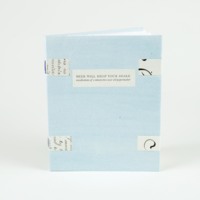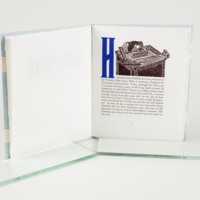D2. Beer Will Help Your Shake: Recollections of a Ninety–Two Year Old Papermaker
D2. Peter Thomas. Beer Will Help Your Shake: Recollections of a Ninety–Two Year Old Papermaker. Oxford: Alembic Press with Peter & Donna Thomas, 1990.
19.5 x 16 cm (7¾” x 6¼”), 18 pages, 114 copies.
Binding: Copies 1-100 have folded blue paper covers, handmade by Peter Thomas, over boards. Pages are sewn over parchment tapes with tapes made of manuscript indentures laced into covers. Title on label on cover. Bound by the printers. Special copies 1-14 are full-bound in old parchment manuscript indentures. Paper: 150 gsm Pott handmade at the Wookey Hole Mill. Printing: Letterpress; printed using Arab Follscap Folio, Albion Demy, and Adana presses. Typography: Monotype Caslon set by Solo–Type. Title hand set in wood type. Title, initial, and ornaments in blue. Illustration: Two linocuts by Donna Thomas. Special copies 1-14 include samples of paper made at the Wookey Hole Mill during Harry Glenville’s tenure.
“In 1988 I went to England to meet Cyril Finn, a retired hand papermaker who had worked at the vat his whole life, to learn the motions of the ‘papermaker’s shake.’ After the interview I asked if there were any other old papermakers around. He replied, ‘If you want to meet a really old papermaker you should go up to Wookey Hole and meet Harry Glanville, the man who trained me.’ I found Harry, who was then 92, in a rest home in Wells. Harry could not answer my questions, but he could tell a good story, which I tape-recorded and, on returning home, transcribed. I made plans to return to England in 1990 to have another interview with Cyril. When I told Claire Bolton of the Alembic Press about the plan she invited me to come visit, proposing we might do some sort of collaborative book project while I was there. After some discussion we decided to print Harry’s transcribed interview on Wookey Hole handmade paper. Claire hosted Donna and I, and our two daughters, for about a week, and in that time we got the pages printed. We had recently been introduced to the concept of making ‘non-adhesive bindings’ and decided that style of binding would be appropriate for this book. About this time English law had changed and lawyers no longer needed to retain century old parchment indenture documents, so there were lots of them on the market. Claire had just bought several dozen and, inspired by their raw beauty, we used them for the bindings of the special copies and also for the straps of the regular copy bindings. We split the edition with Claire, each taking 57 copies.”

